-
Welcome back Guest! Did you know you can mentor other members here at H-M? If not, please check out our Relaunch of Hobby Machinist Mentoring Program!
You are using an out of date browser. It may not display this or other websites correctly.
You should upgrade or use an alternative browser.
You should upgrade or use an alternative browser.
Just purchased a Holbrook Minor
- Thread starter samthedog
- Start date
- Joined
- Nov 21, 2012
- Messages
- 793
Thanks guys. I just landed in Houston Texas a few hours ago so now I am counting the days  )
)
I am investigating the VFD route to replace the variator and joined the yahoo group for Holbrook lathes. I am not sure I understand why there would be a problem using a vfd regarding torque if you have a gearbox that has 2 speed ranges - first gear for threading that is 80 - 500 rpm, and the second gear 500 - 3000 rpm.
The motor is connected to the variator and runs at full rpm - the speed is adjusted at the variator which is then connected to the 2 speed gearbox - the gearbox then turns a pulley belt that heads up to the headstock.
To proceed I would need to know the ratios that the gearbox provides in order to figure out if the VFD is the best option or if I should go with a DC motor. Am I on the right track here?
Paul.
I am investigating the VFD route to replace the variator and joined the yahoo group for Holbrook lathes. I am not sure I understand why there would be a problem using a vfd regarding torque if you have a gearbox that has 2 speed ranges - first gear for threading that is 80 - 500 rpm, and the second gear 500 - 3000 rpm.
The motor is connected to the variator and runs at full rpm - the speed is adjusted at the variator which is then connected to the 2 speed gearbox - the gearbox then turns a pulley belt that heads up to the headstock.
To proceed I would need to know the ratios that the gearbox provides in order to figure out if the VFD is the best option or if I should go with a DC motor. Am I on the right track here?
Paul.
- Joined
- Aug 19, 2013
- Messages
- 764
Thanks guys. I just landed in Houston Texas a few hours ago so now I am counting the days)
I am investigating the VFD route to replace the variator and joined the yahoo group for Holbrook lathes. I am not sure I understand why there would be a problem using a vfd regarding torque if you have a gearbox that has 2 speed ranges - first gear for threading that is 80 - 500 rpm, and the second gear 500 - 3000 rpm.
The motor is connected to the variator and runs at full rpm - the speed is adjusted at the variator which is then connected to the 2 speed gearbox - the gearbox then turns a pulley belt that heads up to the headstock.
To proceed I would need to know the ratios that the gearbox provides in order to figure out if the VFD is the best option or if I should go with a DC motor. Am I on the right track here?
Paul.
I vote VFD hands down. I have 3 VFDs, 1 in service, 1 still in the box, and 1 I'm currently wiring up to replace my 1/2 horse dc drive in my SB 9A. The VFD will provide good torque at low rpm (driving a 3ph motor) when compared with a PM DC motor. The programmable features of a VFD offer all kinds of benefits and options. I'm partial to Automation Direct units. Mine are GS2 models, 2 3HP & 1 1HP. The 1 HP is 120 primary input while the others are 220.
I am not familiar with the variator, but my BP clone has a variable head & I find it very useful to provide high torque @ very low spindle speeds since the motor is running faster than a simple drive (step pulley, etc.). This is very helpful when power tapping plus the VFD will allow a near instant reverse capability.
- Joined
- Nov 21, 2012
- Messages
- 793
Thanks for the input Uncle Harry. My only concern is that even with a constant torque VFD, when I reduce the RPM it will still have reduced torque and I need to find a good solution to this.
At 1440 RPM, the motor is putting out 3 HP, so at 720 RPM through a constant torque VFD, it is putting out 1.5 HP. I need to know what the gearbox range is so I know how to go about using the VFD. The solution may be using a constant torque VFD and having a 2 speed gearbox between the motor and existing gearbox. The lathe has electrical actuation of the existing box and I am sure I could couple the intermediate gearbox to the same electrical system to allow electrical actuation of it too. This would mean that the low range would be reduced by gearing down the motor twice through 2 gearboxes and then having the fine control via VFD to reduce torque loss.
Unfortunately I can only speculate at the moment because I don't know if the variator increases output RPM past the motor's RPM, or what the gear ratios are for the gear box, nor the pulley sizes from the gearbox to the headstock. There are 3 seperate torque and RPM affecting units here that act together and I am not sure where to start at the moment.
Paul.
At 1440 RPM, the motor is putting out 3 HP, so at 720 RPM through a constant torque VFD, it is putting out 1.5 HP. I need to know what the gearbox range is so I know how to go about using the VFD. The solution may be using a constant torque VFD and having a 2 speed gearbox between the motor and existing gearbox. The lathe has electrical actuation of the existing box and I am sure I could couple the intermediate gearbox to the same electrical system to allow electrical actuation of it too. This would mean that the low range would be reduced by gearing down the motor twice through 2 gearboxes and then having the fine control via VFD to reduce torque loss.
Unfortunately I can only speculate at the moment because I don't know if the variator increases output RPM past the motor's RPM, or what the gear ratios are for the gear box, nor the pulley sizes from the gearbox to the headstock. There are 3 seperate torque and RPM affecting units here that act together and I am not sure where to start at the moment.
Paul.
- Joined
- Dec 29, 2013
- Messages
- 321
Thanks for the input Uncle Harry. My only concern is that even with a constant torque VFD, when I reduce the RPM it will still have reduced torque and I need to find a good solution to this.
At 1440 RPM, the motor is putting out 3 HP, so at 720 RPM through a constant torque VFD, it is putting out 1.5 HP. I need to know what the gearbox range is so I know how to go about using the VFD. The solution may be using a constant torque VFD and having a 2 speed gearbox between the motor and existing gearbox. The lathe has electrical actuation of the existing box and I am sure I could couple the intermediate gearbox to the same electrical system to allow electrical actuation of it too. This would mean that the low range would be reduced by gearing down the motor twice through 2 gearboxes and then having the fine control via VFD to reduce torque loss.
Unfortunately I can only speculate at the moment because I don't know if the variator increases output RPM past the motor's RPM, or what the gear ratios are for the gear box, nor the pulley sizes from the gearbox to the headstock. There are 3 seperate torque and RPM affecting units here that act together and I am not sure where to start at the moment.
Paul.
Well, I just did some quick back of the envelope calculations (see attached) and it looks like the Variator goes from a 1:3 ratio at the low end to a 2:1 ratio at the high end. The Gear box is ~6:1 from the data you gave (6.25:1 based on the low end, 6:1 based on the high end). If you do decide to go with a VFD, one option would be to use a larger HP motor to give more low end torque. We have a Acra bridgeport clone at work that has a 3HP motor instad of the 2HP usually found on 2J Bridgeports. Another thing to consider is that a VFD can also increase the output frequency past the line frequency. So If you can find a motor that is rated up to 3000 RPM, you can use a smaller pulley ratio between the motor and the gear box and still get the same top spedd you used to have.
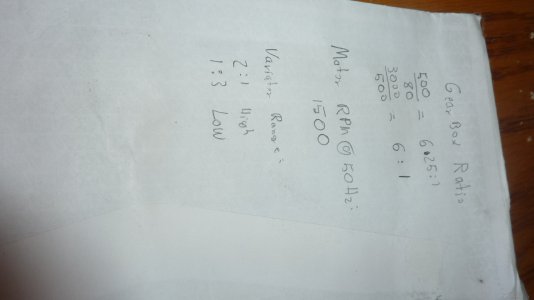

F
f350ca
Forum Guest
Register Today
Just for a comparison on power, my older Hardinge HLV only has a 1 HP 2 speed motor on it. It never seems short on power. But my Summit 16 inch has a 10 HP motor, apples and oranges, you'll probably never be hogging metal with your Holbrook that you'd really need the torque.
Greg
Greg
- Joined
- Nov 21, 2012
- Messages
- 793
Thanks for input guys - I really do appreciate it. This is foreign territory for me because I am usually super picky and careful with buying machines. I took a chance on this one as it is a rare and very highly regarded machine so any help or advice is welcome.
The first thing I will do is see if I can tweak the variator. It may be the case that it just needs an oil change, a wash out and then an adjustment. Many people run the wrong oil too which does not help matters. I always buy the best oil I can and in this case I paid $400 for 20 litres for the correct grade oil for this application as the Chipmaster also has a variator and I wanted to make sure it would last.
Paul.
The first thing I will do is see if I can tweak the variator. It may be the case that it just needs an oil change, a wash out and then an adjustment. Many people run the wrong oil too which does not help matters. I always buy the best oil I can and in this case I paid $400 for 20 litres for the correct grade oil for this application as the Chipmaster also has a variator and I wanted to make sure it would last.
Paul.
- Joined
- Nov 21, 2012
- Messages
- 793
Ok gents, maybe some of you would like some more pictures of a Holbrook Minor. This is not my machine but rather one that someone has restored on the yahoo group. He gave me permission to post pictures of the wonderful work he has done. If mine comes out even half as good I will be overjoyed!
Enjoy:
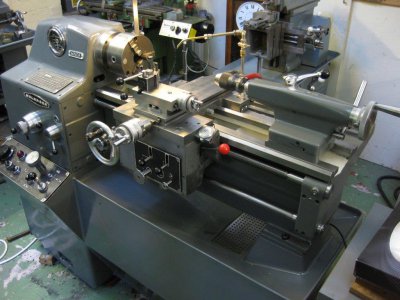
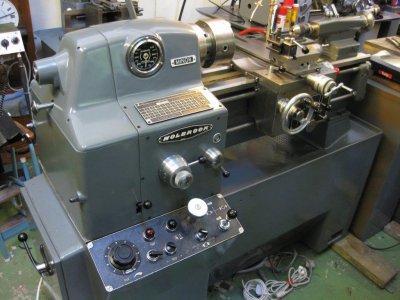
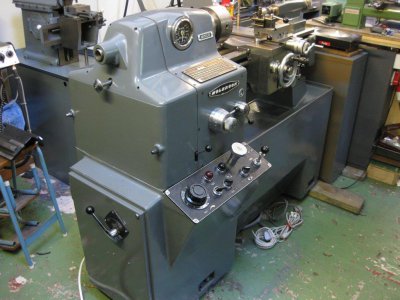
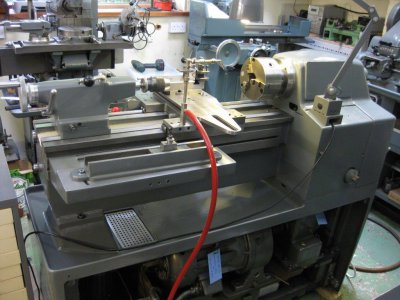
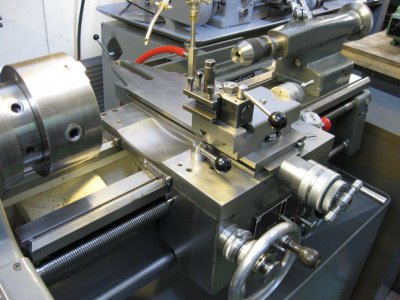
Paul.


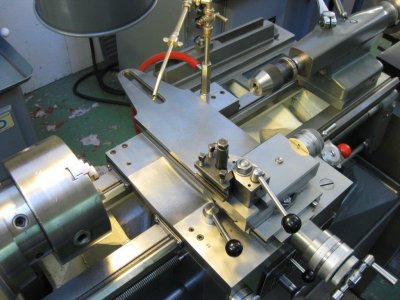



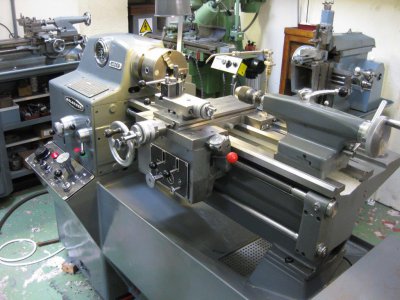
Enjoy:





Paul.







- Joined
- Nov 21, 2012
- Messages
- 793
Hey guys, unfortunately the lathe turned out to be a lemon. The ways were dinged up and quite badly scraped by careless operation. Oil lubrication points were filled with grease and there was unacceptable backlash. For the price I had to walk away, especially when my Chipmaster is such a sweet little lathe. I didn't want to swap out the Chippie that is near perfect for a machine that would be a major project requiring new parts and bed regrinding.
Call me silly, I just didn't feel like a dragged out project at this time.
Paul.
Call me silly, I just didn't feel like a dragged out project at this time.
Paul.
- Joined
- Jul 26, 2011
- Messages
- 4,142
That is too bad. There was a Holbrook Minor on Tony's site for sale a while back. I think it was 6,000 Pounds. It was a lathe model,like the nice one you pictured. But,that means the knobs were made straight,rather than properly contoured,as Tony mentioned in his writeup of the Holbrook Minor. I'd loved to have had it,but it was in England. I don't know how I could have gotten it crated and shipped. I'd have made proper knobs for it,and refinished the paint(which I recall was an ugly light green color).
They certainly made some super high grade machines back in the day. Super expensive at the time,too. I think Tony mentioned that this lathe cost as much as a small house,but that could have been another lathe.
Your chip master is still a wonderful small lathe anyway. I'm lucky to have an HLVH for a small lathe,and a 16" X 40" Grizzly made in Taiwan for my larger one. Nothing wrong with it, and very accurate, but I'd love to replace it with a fine old "REAL" lathe if I ever could find one not worn too much.
They certainly made some super high grade machines back in the day. Super expensive at the time,too. I think Tony mentioned that this lathe cost as much as a small house,but that could have been another lathe.
Your chip master is still a wonderful small lathe anyway. I'm lucky to have an HLVH for a small lathe,and a 16" X 40" Grizzly made in Taiwan for my larger one. Nothing wrong with it, and very accurate, but I'd love to replace it with a fine old "REAL" lathe if I ever could find one not worn too much.

